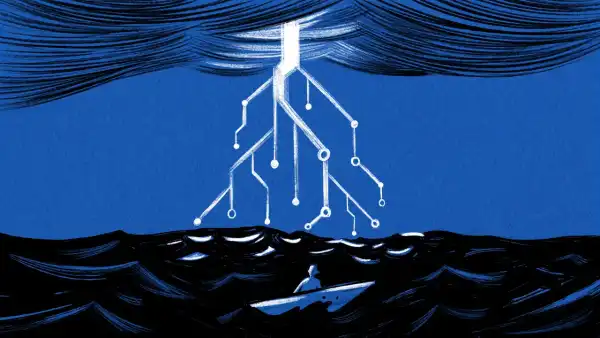
Save this storySave this storySave this storySave this storyYou’re reading Open Questions, Joshua Rothman’s recurring piece that delves into the essence of human existence.
One of the most iconic edits in cinematic history, taken from “2001: A Space Odyssey,” wonderfully embodies an idea known as the technological sublime. Initially, we observe an irate ape striking one of his kin until death using a discovered bone; he has only just understood that bones can be utilized in such a manner, and he throws his weapon into the heavens in celebration. We trace the bone skyward as it spins through the pristine blue sky. Then, abruptly, we shift to deep space, millions of years into the ape’s future. The bone is now a sophisticated satellite, coasting past the curvature of Earth. Throughout the following moments, as a spacecraft connects with a space station, we discern just how greatly humankind has advanced.
If you’ve come across any science fiction, you’ve known the technological sublime—the sense of wonder, intertwined with apprehension, that can arise when facing the overwhelming potential of technological advancement. Perhaps you’ve gawked at the expansive cyber-cityscapes of “Blade Runner,” or at the remarkably tall, leaf-resembling alien vessels in “Arrival.” In the flowing green code of “The Matrix,” you might have perceived a hint of enlightenment—or perhaps Ava, the incredibly beautiful android brought to life by Alicia Vikander in “Ex Machina,” has stimulated some notion of what it could signify to transcend humanity. In all of these instances, technology feels immense, peculiar, unstoppable, yet also intellectually stimulating and captivating—an invigorating surge that will seize you.
These are visions of a yet-to-be-realized tomorrow. Nevertheless, the technological sublime also exists in our current reality. Years ago, while I was in grade school, we watched the space shuttle launch from Cape Canaveral, mesmerized by the might of its engines even on our classroom’s small screen. Nowadays, crowds gather to witness towering SpaceX boosters return to our planet, where they are captured by massive robotic arms. Rocketry appears as futuristic, yet, in reality, the modern iteration of it is a century old—and thus, when we are thrilled by it, we are thrilled not by a dream but by a tangible aspect of life. As I make my way to The New Yorker’s headquarters, located in One World Trade Center, I often tilt my gaze to follow the building’s contours as they ascend towards its pinnacle. Such architecture conjures a city from the future, but it is present in the here and now, and the innovations that enable it—steel frameworks and facade systems, H.V.A.C. installations and lifts—date back to the nineteenth century. We dwell, and have dwelled for an extended period, within a high-tech era.
“The sublime” is an ancient notion. It indicates, at the very least, an exceptionally transformative aesthetic experience, perhaps the ultimate type. The author of “On the Sublime,” a two-thousand-year-old Greek text, linked it to an enduring literary prominence—the kind evoked by a phrase such as “Let there be light.” In the eighteenth century, the concept shifted, when philosophers associated it with the natural world. In a pivotal discourse, “A Philosophical Enquiry Into the Origin of Our Ideas of the Sublime and Beautiful,” Edmund Burke differentiated between two categories of aesthetic experience: a pleasant, non-intimidating form of beauty (consider a flower, or a poem), and a more frightening form of beauty, which we might encounter when facing a thunderous cascade or an unending stretch of desert. The waterfall and the desert minimize us; they disregard us; they are capable of ending us. Yet we find them sublime, provided we can appreciate their force from a secure distance. The sensation of sublimity, Burke wrote, is “not pleasure, but a sort of delightful horror, a sort of tranquility tinged with terror.” The sublime awakens in us “astonishment,” he continued, and also “awe, reverence, and respect.”
In comparison to the natural manifestation of the sublime, the technological variant has always felt somewhat inferior. The historian Perry Miller, who initially and definitively characterized the technological sublime, during the nineteen-sixties, viewed it as a particularly American occurrence. Our national dedication to capitalism and industry had merged with our moral enthusiasm, he contended, to forge a civic religion founded on breathtaking technological achievements. A drawback of revering technologies, naturally, is that, unlike conventional sacred objects, they become obsolete, even quaint, as they age. Miller wrote that the steamboat once inspired feelings of technological sublimity: it was “a subject of ecstasy for its sheer majesty and might, especially for its stately progress at night, blazing with light through the swamps and forests of Nature.” Currently, it’s an attraction at Disney World.
Within “The Machine in the Garden,” dating back to 1964, Leo Marx illustrated how, as the nation evolved, the “rhetoric of the technological sublime” had obscured opposition to novel technology. It had empowered techno-optimists to assert that there existed a spiritual facet—an elevation—to the comprehensiveness with which industrialization would encroach upon a long-cherished perception of a rural America. Thirty years later, in “American Technological Sublime,” David E. Nye examined the commonplace methods through which we venerate technology—factory visits; dazzling concerts with light displays; observation decks atop skyscrapers—and celebrated its egalitarian essence. We are all distant from God, yet we can journey in jets, possess iPhones, receive mRNA immunizations, and converse with ChatGPT. A multitude of the most remarkable technologies are available to everyone.
However, in the context of technology, is the term “sublime” truly fitting? When emerging technologies spark awe and apprehension, are those sensations genuine? Or are they simply outputs of sci-fi fandom or corporate marketing, manufactured by Mark Zuckerberg, Elon Musk, and other tech magnates aiming to persuade us that smartphones, household automatons, or neural interfaces represent a second coming? All of this appears feasible—and nonetheless the technological sublime can still register as a truthful response to the world we inhabit, which is influenced by technology at every echelon, in ways we struggle to envision or manage.
It’s tempting to propose that technology is not natural—that it’s crafted by us—and that this is a primary manner in which the technological sublime differs from the natural form. However, there is a viewpoint from which technology is not entirely human-made. In “Oppenheimer,” everyone experiences wonder and fear at the prospect of the atomic weapon. The roots of fear are apparent. Wonder comes along within the allure of physics. The bomb is made attainable through human insights into the essence of reality; fission’s ability to conclude everything arises from our freshly acquired comprehension of how everything is composed. Nature and humanity intertwine, and this is a constituent of what inspires astonishment.
It’s conceivable to extend this line of reasoning further, and to assert that there exists a degree of autonomy concerning technology—that it participates in its individual creation. In an influential essay, “What Technology Wants,” Kevin Kelly characterizes the totality of our technical systems as “the technium” and argues that this “organism-like” assemblage has “tendencies.” “We humans want certain things from the technium, but at the same time there is an inherent bias in the technium outside of our wants,” Kelly writes. For one aspect, “technology will head in certain directions because physics, mathematics, and realities of innovation constrain possibilities”; for another, technology by itself tends to advance in ways that amplify efficiency, “evolvability,” and other advantageous attributes. For these rationales, Kelly contends, were we to explore alien civilizations, we’d likely discover that they possessed at least some analogous technologies: “Any civilization that invents nuclear power,” for example, “will hit upon a small set of workable solutions.” In this sense, technology is not merely something we devise; it’s similarly like a terrain we survey. It’s abundant with phenomena—such as the atom bomb—that will inevitably be unearthed.
There’s a complexity to the natural manifestation of the sublime. We desire to encounter reality, yet securely. By remaining behind the barrier, we can appreciate the strength of Niagara Falls as an aesthetic subject, whereas were we within the current and approaching the descent, we’d experience solely terror. Technological sublimity, in like manner, necessitates barriers. These can be both tangible—we observe auto racing from behind obstacles—and intellectual. By comprehending our technologies, we learn to regulate them, rendering them more secure. And yet a technology that is entirely regulated lacks a sublime thrill. Driving was formerly technologically sublime: Americans were so enamored with internal-combustion vehicles that the Beach Boys could compose songs about them, and it was stimulating to be a mechanic, to learn the intricacies of the perpetually evolving automobile. It could even be glamorous to perish in a car collision, as in the teen-tragedy songs of the nineteen-fifties and sixties (“Leader of the Pack,” “Dead Man’s Curve,” “Tell Laura I Love Her,” and so forth). Now driving is tedious. The fresh sublime resides in autonomous vehicles. You experience wonder and fear when you release your grip on the steering apparatus.
The inescapable march of technology, in other words, renders the technological sublime evasive. And it’s additionally valid that technologies incline to diminish themselves, adopting unassuming disguises. (“Technologies tend toward ubiquity and cheapness,” Kelly writes.) My son and I occasionally toss around a “hoverball”—a diminutive propeller-driven sphere that illuminates in the darkness, and which can be manipulated to float elegantly from person to person, or to follow a boomerang trajectory. The hoverball is amusing, not sublime, and yet technological sublimity is concealed within it: the flight mechanisms within the hoverball are affiliated with those that have instituted lethal “gray zones” on the Ukrainian battleground, into which no human can venture without risking demise by drone.
Standing on the seashore at night, gazing outward at the shadowy, enigmatic ocean, it’s effortless to feel challenged by something far more substantial and ancient than oneself. The natural sublime is grand, showy, unmistakable. With technology, such instances can materialize discreetly. Periodically, you might discern a security camera in the corner of a room, and recollect that we are perpetually under surveillance. Spotting a satellite traversing the night firmament, you might contemplate how our species’ span is expanding; ingesting your daily statin, you might consider how engineered our bodies are. In this fashion, the technological sublime can be a dispersed sensation, encountered in fractions. If you’re a technophile, it’s something you might pursue, by constantly pursuing the cutting edge.
Technologists are rational—at least, that’s the presumption. But they are additionally individuals, and individuals inhabit culture and possess emotions, and the patterns through which those emotions are encountered have been essentially the same since the era of Edmund Burke. Listen to the titans of tech converse about their endeavors, and you’ll frequently observe the motifs of the technological sublime. A.I. researchers at the “frontier labs,” for instance, speak in somber tones concerning the hazards presented by artificial intelligence, which they deem a sort of destined discovery, virtually a potentiality of the cosmos, to which they are near witnesses. The reality that they aren’t entirely in command of these systems appears to amplify their sensation of being in the presence of something sublime.
Sublimity encompasses an aspect of passivity. Once, I embarked on a solitary walk within Red Rock Canyon, located in Nevada; the temperature exceeded a hundred degrees, and the sun was blinding. Standing on a desolate stretch of path overlooking a chasm, with no one present and my water vessel depleted, I recognized the precariousness of my actions. I ought to have retreated immediately, yet instead I lingered, absorbing the ancient rust-hued canyon, feeling simultaneously overwhelmed and intensely alive. The world was expansive, and indifferent to me, yet there I was, comprehending this truth. I relished the fusion of wonder and dread.
But is this the appropriate manner in which we should react to technology? The philosopher Arthur Schopenhauer was fascinated by the instant when a terrifying occurrence transmutes into sublime; it’s almost, he contemplated, as if we confront a selection between fretting about ourselves or transcending selfhood. Adopt the latter route, toward sublimity, and one becomes a “pure, will-less subject of knowing,” an “eternal subject”—an individual who undergoes “exaltation” at having ascended out of themselves. This sounds terribly esoteric, but it’s a suitable depiction of the sensation of standing in reverence and fear of something greater than yourself. Individuals who pursue the sublime in nature—mountaineers, scuba enthusiasts, and the like—are frequently in search of it.
Sublimity is not an illusion. There exist explanations for why we sense it within nature, and explanations for why we encounter the technological rendition as well. Yet in both scenarios, it’s crucial to shatter the daze. At a certain juncture, you must flee from the advancing swell. You must revert to yourself—to recollect, and embrace, the reality that you’re a distinct individual with agency, obligations, and values. Within the natural realm, reverting to yourself can be as straightforward as departing. However, within the technological one, it’s more intricate, because we are in authority of the tempo of exploration, discovery, and invention. Technologists can, to a degree, conjure the technological sublime, and consumers of technology can become dependent on it. But the trajectory toward accountability navigates through disillusionment. ♦
Sourse: newyorker.com







